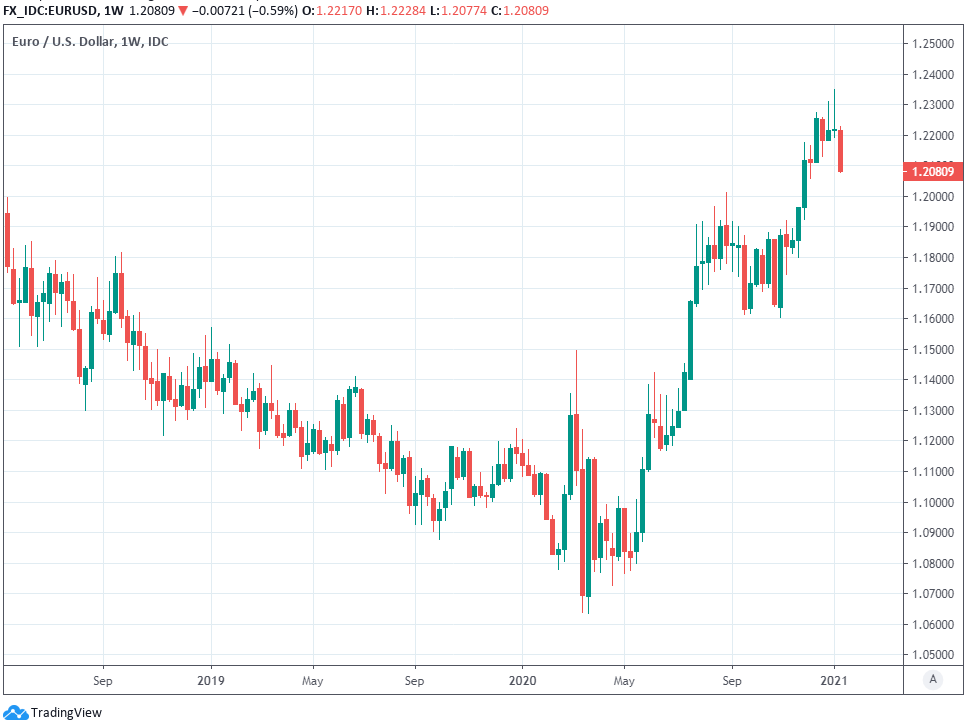Market News
Euro-Dollar Ends Worst Week Since October and Needs Rally by Sterling or Yuan to Sustain a Rebound - POUND STERLING LIVE
- EUR/USD rally stalls at 1.2350 as TWI reaches new highs.
- Central bank concerns may tie EUR/USD's fate to GBP, CNH.
- GBP & CNH rallies key for sustainable EUR rebound off 1.20.

Image © David Holt, Accessed: Flikr, Licensing Conditions: Creative Commons
- EUR/USD spot rate at time of writing: 1.2092
- Bank transfer rate (indicative guide): 1.1657-1.1742
- FX specialist providers (indicative guide): 1.1899-1.1995
- More information on FX specialist rates here
The Euro was carrying its largest weekly loss for nearly three months on Friday after capitulating previously at what were new multi-year highs for the trade-weighted single currency, only now the Euro-to-Dollar rate may need a rally from either the Pound or Chinese Yuan to sustain a meaningful recovery.
Europe's single currency briefly planted its flag at the 1.2350 level early in the New Year, which coincided with a new post-20217 peak in the trade-weighted Eurozone exchange rate, from where it capitulated in price action that likely had multiple drivers.
Investors' profit-taking on wagers against the Dollar and a break higher in American bond yields has played a key role in a nascent comeback for the U.S. currency, which ended its best week for months on Friday. This left the Dollar within arm's reach of becoming the best performer of 2021, although the Pound pipped it to that particular post.
Meanwhile, various factors have been cited by analysts for weakness in the Euro including prolonged 'lockdown,' a slower pace of vaccination and political uncertainty in Italy, although if European Central Bank (ECB) concerns about currency strength weren't also in the mix they almost certainly will be upon any eventual rebound by the Euro-to-Dollar rate.
"Whatever your perspective, it is still fairly remarkable to hear the head of a major central bank highlighting the 'positive' factors impacting the global economy while verbally talking their own currency lower," says Stephen Gallo, European head of FX strategy at BMO Capital Markets.
Above: Euro-to-Dollar exchange rate at weekly intervals.
Bearish views abound when it comes to the Dollar's prospects in 2021 and it's this downbeat outlook that explains why so many forecasters are looking for the Euro-to-Dollar exchange rate to hit 1.25 sooner or later, it's highest since the opening of 2018. But the European Central Bank may have other ideas in the absence of a rally in the Pound-to-Euro exchange rate or further steep falls in the value of the U.S. Dollar relative to the Chinese Yuan.
This is because without the latter, any recovery in EUR/USD would take the trade-weighted Euro back to problematic levels. At last week's peak of 1.2350, some measures of the Eurozone's trade-weighted exchange rate had already risen above the August-to-September 2020 high, which was itself over and above the peak achieved in even the prior 2017 EUR/USD rally that did eventually see bids and offers accepted around 1.25.
"ECB President Lagarde frustrated euro bulls with remarks that the central bank is “extremely attentive†to the FX impact on inflation. The political crisis in Italy and resulting widening of the 10y BTP/Bund spread to 121bp did not help matters," says Carole Laulhere, a strategist at Societe Generale.
Currency strength is a problem for central banks when inflation metrics are a long way below the levels prescribed statutory mandates and the ECB has long struggled to meet its inflation targets, which is why it was was first last September out of a now-growing number who've since complained about what's effectively the Dollar downturn.
President Christine Lagarde was at pains to stress this week that the ECB's objections are not motivated by concerns about the competitiveness of exports, but rather the cheapening costs of imports and how those could feed through to even lower inflation for longer.
Irrespective of whether it's the import or export side of the equation, the U.S. Dollar, Chinese Yuan and Pound Sterling are still collectively responsible for more than half of the Eurozone's trade-weighted exchange rate from each direction and aren't even close to being matched in their individual sizes by any other currencies. As a result, it would take a substantial rally in either the Yuan or Pound to prevent the Eurozone TWI from rising again in any scenario where EUR/USD rebounds toward last week's 1.2350 high.










